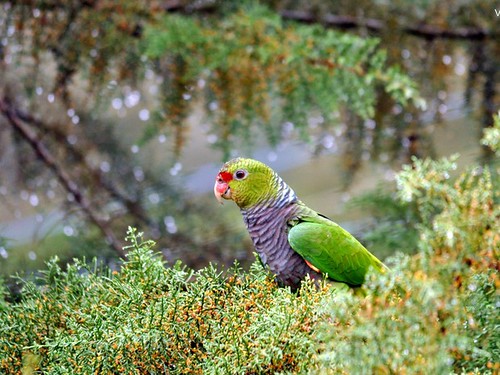 Vinaceous-breasted Amazon conservation in western Santa Catarina Park (Photo: Vanessa Kanaan/Espaço Silvestre)The site was created in 2005 and preserves 12,841 acres of native forest in Santa Catarina state. The locally extinct parrot was reintroduced in 2010
Vinaceous-breasted Amazon conservation in western Santa Catarina Park (Photo: Vanessa Kanaan/Espaço Silvestre)The site was created in 2005 and preserves 12,841 acres of native forest in Santa Catarina state. The locally extinct parrot was reintroduced in 2010
The Vinaceous-breasted Amazon and Araucaria pines are the main species preserved in Araucaria National Park in western Santa Catarina state, Brazil. Created in 2005, t
he site preserves 12,841 acres of forest and is situated between the cities of Ponte Serrada and Passos Maia.
 Monthly Parrot surveys monitor the parrot population (Photo: Espaço Silvestre)
Monthly Parrot surveys monitor the parrot population (Photo: Espaço Silvestre)
Among the Parks main projects is the conservation of the Vinaceous-breasted Amazon. The species had long been extinct but was reintroduced back in the park in 2010. The species did occur there historically but had not been sighted in the region for 20 years.
Since 2010 43 birds were released and are monitored regularly by Espaço Silvestre Instituto Carijós staff. All birds were confiscated by police in wild bird trafficking cases. Birds have been put trough a varied training program for their rehabilitation. In September the project was able to release the second group of rehabilitated birds of the year.
 Hopefully the parrots will start breeding and grow a new population in the state. (Photo: Espaço SilvestreNormally Vinaceous-breasted Amazons breed between August and January, and the biologists hope this year will be productive. Apart from working with the animals in the field, work is also done with the communities.
Hopefully the parrots will start breeding and grow a new population in the state. (Photo: Espaço SilvestreNormally Vinaceous-breasted Amazons breed between August and January, and the biologists hope this year will be productive. Apart from working with the animals in the field, work is also done with the communities.
The goal is for people become aware of these special birds and their environment so that they will not kill or capture them for food and other purposes. Work is also done to encourage local craftsmen to adopt parrots as a theme in their work. The income this generates will help their families but the products also advertise the project. "We need more sponsors if we want to continue our research and conservation work," says Vanessa.
Araucaria Forest
 Araucaria forest is the main habitat of the Vinaceous-breasted Amazon (Photo: Araucaria National Park)The Araucaria forest produces the pine seeds that is the staple diet for the parrots. It therefore also needs to be conserved. The Araucaria is also known as the Paraná pine or Brazilian pine, an endangered species that depends on other plant species to grow. Araucaria only occur in established forests. These trees can reach heights of up to 50 meters with a diameter of 2.5 m and can live for 700 years.
Araucaria forest is the main habitat of the Vinaceous-breasted Amazon (Photo: Araucaria National Park)The Araucaria forest produces the pine seeds that is the staple diet for the parrots. It therefore also needs to be conserved. The Araucaria is also known as the Paraná pine or Brazilian pine, an endangered species that depends on other plant species to grow. Araucaria only occur in established forests. These trees can reach heights of up to 50 meters with a diameter of 2.5 m and can live for 700 years.
 Araucárias Wood was exploited for export (Photo: Espaço Silvestre) The forest in the National Park is reduced to less than 3% of its original size and only survives in the highlands of Rio Grande do Sul, Santa Catarina and Paraná. The high quality wood made the Araucaria popular and was intensively logged from the start of the twentieth century. It is estimated that between 1930 and 1990, about 100 million pine trees were felled.
Araucárias Wood was exploited for export (Photo: Espaço Silvestre) The forest in the National Park is reduced to less than 3% of its original size and only survives in the highlands of Rio Grande do Sul, Santa Catarina and Paraná. The high quality wood made the Araucaria popular and was intensively logged from the start of the twentieth century. It is estimated that between 1930 and 1990, about 100 million pine trees were felled.
The list of animal species that are threatened by the reduction of the Araucaria Forest goes on. It includes the crow The Azure Jay (Cyanocorax caeruleus), Red-spectacled Amazon (Amazona pretrei) and the Puma (Puma concolor). Plant species, such as Nectandra lanceolata, Aspidosperma polyneuron and Dicksonia sellowiana are also threatened.
More information about the Vinaceous-breasted Amazon on the project website.